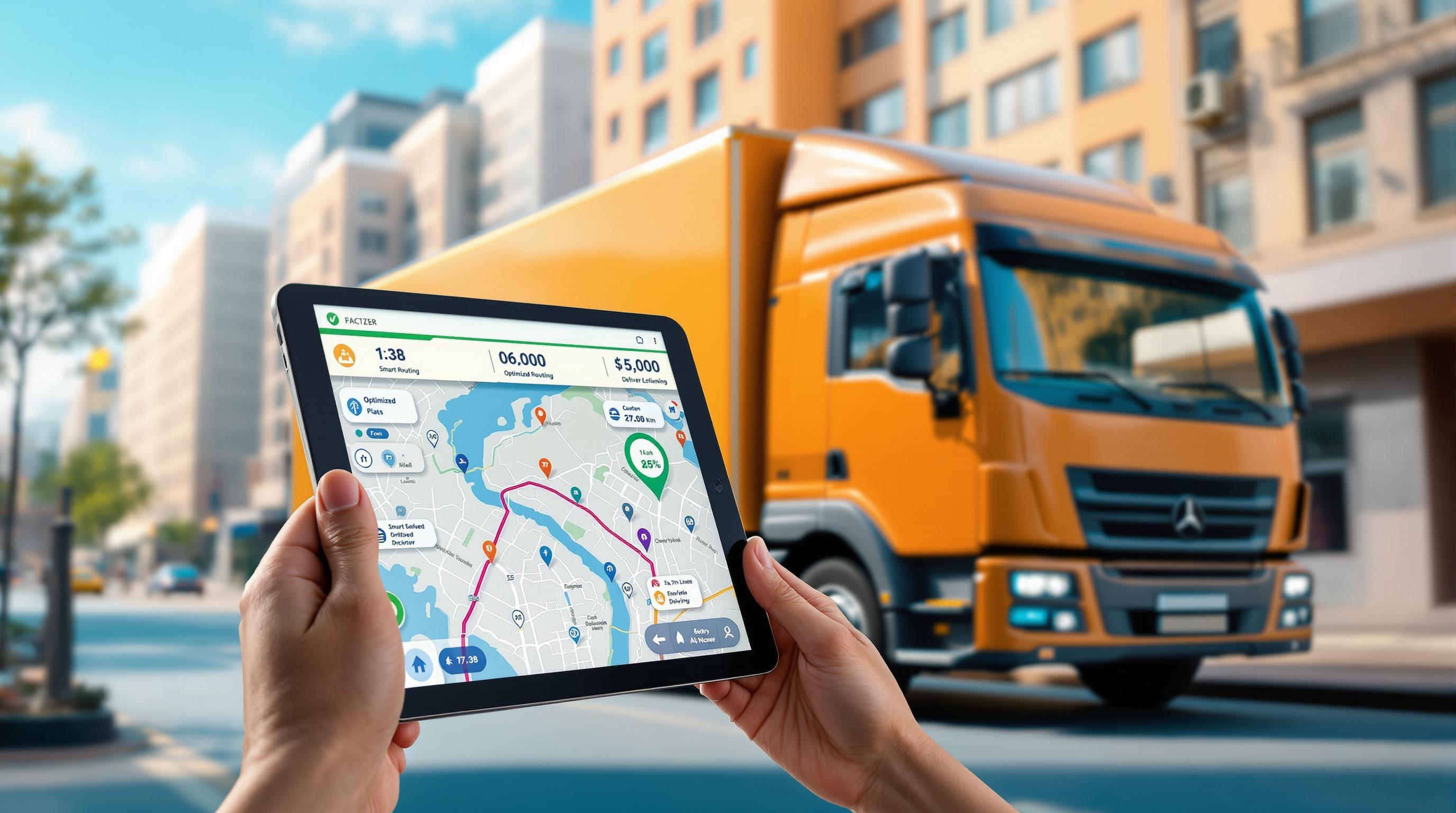Switching from manual to AI-powered route planning can save time, cut costs, and improve efficiency for field service managers. Here’s why it matters:
- Boost Productivity: AI improves field worker productivity by 10%.
- Save Costs: Reduces operational costs by 18%, including fuel expenses.
- Increase Service Capacity: Handle up to 100% more service calls.
- Enhance Customer Retention: Decreases churn by 22%.
Why AI Beats Manual Planning
- Real-Time Traffic Updates: AI adjusts routes based on live traffic for accurate ETAs.
- Unlimited Stops: Unlike traditional tools, AI planners handle unlimited stops with dynamic reordering.
- Time Window Management: Ensures timely service while balancing efficiency.
Quick Comparison
| Feature | Manual Planning | AI Route Planning |
|---|---|---|
| Stop Limit | Limited | Unlimited |
| Traffic Updates | Basic | Real-time |
| Route Optimization | Fixed Order | Dynamic |
| Multi-Driver Support | No | Yes |
Next Steps
- Identify Issues: Track travel times, fuel usage, and missed appointments.
- Choose AI Tools: Look for software with real-time traffic integration and scalability.
- Train Teams: Roll out training in phases to ensure smooth adoption.
- Monitor Metrics: Use KPIs like fuel efficiency, on-time rates, and customer satisfaction to measure success.
AI route optimization simplifies workflows, reduces costs, and improves customer satisfaction. Start small with a pilot program and scale up for maximum impact.
Field Service Route Optimization Demo
Core AI Route Planning Features
Modern AI routing systems help streamline field operations by cutting down on drive time and minimizing wasted resources. These tools combine several features to deliver efficient routing solutions.
Live Traffic Updates
AI-powered traffic monitoring improves ETA predictions by using real-time data from various sources. For example, Google Maps' integration with DeepMind's Graph Neural Networks has boosted ETA accuracy by up to 50% in certain cities.
"When it's working, it's invisible. Getting it right means nobody notices that you're doing it." - Jason Laska, Principal Software Engineer, Lyft
Lyft's system, for instance, can predict pickup ETAs with a one-minute margin and dropoff times within two minutes. For field service teams, this level of precision ensures tighter service windows and less wasted time on the road. AI also handles complex stop sequences with ease, making it a versatile tool for operations.
Multiple Stop Planning
AI also shines when it comes to planning routes with multiple stops. Traditional tools like Google Maps often fall short for field service needs - they limit routes to 10 stops and don’t optimize the stop order.
| Feature | Traditional Tools | AI Route Planners |
|---|---|---|
| Stop Limit | 10 stops max | Unlimited stops |
| Route Optimization | Fixed order | Dynamic reordering |
| Traffic Integration | Basic updates | Real-time adaptation |
| Multi-driver Support | No | Yes |
AI route planners go beyond these limitations. They dynamically reorder stops based on real-time traffic, service priorities, road restrictions, weather conditions, and driver schedules.
Time Window Management
AI systems also excel at managing time windows, balancing customer expectations with operational efficiency. For example, Fieldproxy's AI tools have been a game-changer:
"Our AI team saves 12 hours/week per employee. Nora, Max & Yori have started handling 80% of our customers scheduling, email and data retrieval tasks"
Setting Up AI Route Planning
Leverage AI tools to create a routing system that addresses your specific operational challenges.
Route Problem Assessment
Start by identifying the issues in your current routing process. Common problems include missed appointments, excessive fuel consumption, and long customer wait times. Document these pain points to guide your improvements.
Focus on these key areas:
| Assessment Area | Metrics to Track | Impact on Operations |
|---|---|---|
| Travel Time | Average minutes between stops | Influences service capacity |
| Fuel Usage | Gallons per route | Directly affects costs |
| Customer Wait Time | Minutes outside service window | Impacts customer satisfaction |
| Route Completion | % of scheduled stops completed | Reflects team efficiency |
AI Software Selection Guide
Choose a software solution that aligns with your current systems and operational goals. For instance, Routemize offers features like real-time traffic analysis and appointment location optimization during its beta phase. This makes it a good option for teams wanting to explore AI routing without upfront costs.
When evaluating software, consider:
- Compatibility with your field service management tools
- Scalability for expanding territories and teams
- Ease of use for mobile apps
- Automated customer notifications
- Strong data security protocols
Once you've selected a tool, focus on preparing your team to use it effectively.
Staff Training Plan
Roll out training in phases to ensure a smooth transition:
- Assess the team's current tech skills
- Conduct hands-on training in small groups with real-world scenarios
- Track performance metrics to identify areas for ongoing improvement
sbb-itb-7020db0
Tracking Route Improvements
Keep an eye on how well your routes are performing by using key performance indicators.
Key Success Metrics
Measure the success of your route planning with these important metrics:
| Metric Category | Key Measurements | Observations |
|---|---|---|
| Fuel Efficiency | MPG, idle time | Aggressive driving can reduce gas mileage by 15–30% on highways and 10–40% in stop-and-go traffic. |
| Time Management | Average drive time, stops per hour | AI-powered routing can outperform manual planning by about 30%. |
| Service Quality | On-time arrival rate, customer satisfaction | Optimized routes have been linked to a 10-point boost in on-time performance. |
| Cost Reduction | Fuel costs, overtime hours | Driving over 50 mph can add $0.22 per gallon for every 5 mph over the limit. |
Michael Helta, Chief Innovation Officer at MDOT MTA, highlights the importance of data:
"We've been able to get eight or ten departments across the agency to use Swiftly. We are shifting the agency culture to understand data. We are shifting from anecdotes to data-driven decision-making and increased understanding. It's making us a more inquisitive agency, which leads to better discussions and a stronger end results for our customers."
These metrics can help pinpoint areas for improvement, which are explored further below.
Data-Driven Improvements
Use performance data to make meaningful changes:
-
Monitor Speed Patterns
Look at vehicle speeds to find inefficiencies. Using cruise control on highways can help maintain steady speeds and improve fuel efficiency. -
Optimize Vehicle Load
Remove unnecessary equipment or materials from vehicles. Carrying an extra 100 pounds can lower MPG by about 1%. Additionally, avoid roof-mounted cargo, as it can reduce fuel economy by up to 25% at highway speeds. -
Track Real-Time Adjustments
Use real-time route monitoring to make quick planning changes."RouteManager makes it easy for me to meet requests and give my team visibility on where a driver is throughout the day. This tool has drastically improved communication among several teams."
- Project Manager, Recker & Boerger
"Our internal On-Time Performance Group uses Swiftly data to monitor the success of our network redesign. We would see that we've increased on-time performance ten points from this previous time. That was a really good, quick, and easy way of checking, 'Did we get this right?'"
- Linda Morris, Chief of Service Planning, Miami-Dade Transit
Here are some additional practices to focus on:
- Compare actual versus scheduled run-times to validate routes.
- Break down performance data by individual operators for better insights.
- Monitor headway adherence to prevent buses or vehicles from bunching.
- Keep an eye on idle time, which can burn up to half a gallon of fuel per hour.
Common Route Planning Problems
Data Connection Issues
AI-based route planning relies on accurate and up-to-date data. Problems like incomplete addresses, outdated information, delayed traffic updates, and scheduling conflicts can disrupt the process. To tackle these, consider using automated validation tools, redundant data sources with local caching, and standardized scheduling practices.
FieldAware's Smart Scheduler is a great example of effective data integration. It processes multiple data inputs at once, including:
- Service regions and boundaries
- Worker skill certifications
- Real-time technician locations
- Route efficiency parameters
- Technician working hours and availability
Staff Adoption Barriers
Getting your team on board with new routing technology can be challenging. Kabannas, a UK-based hotel group, faced initial resistance when adopting a new system. Louise Garner, their Commercial Director, shared:
"A few team members who had worked for the previous owners of the properties with a traditional reservations department were a little resistant and not used to answering pre‐arrival questions. This was quickly resolved once they saw how easy HiJiffy is to use. We also asked their feedback on what information we could add to the chatbot to help them. When they sent in ideas, which were subsequently loaded into the system, it was an instant attitude change for some of the team as they felt valued and could see how the 'tool' was a great addition to our guest experience."
To address adoption challenges, involve your team early in the process, provide role-specific training, and secure leadership support. Set clear goals for success and maintain open feedback channels. These steps can help smooth the transition and ensure your team sees the value in the new system.
AI and Human Decision Balance
A mix of AI recommendations and human judgment is key for effective route planning. Studies suggest that predictable AI performance often works better in collaboration with humans than aiming for peak accuracy alone.
The best approach is to let AI handle routine tasks, like optimizing routes, while leaving complex decisions to human expertise. Allow for manual adjustments when necessary and set clear guidelines for when these overrides should happen.
The focus isn’t on achieving flawless AI accuracy but rather on improving overall team efficiency. This involves balancing verification costs and leveraging the strengths of both humans and machines.
Next Steps
Key Benefits
AI-powered route optimization helps reduce travel time, improve fuel usage, increase service capacity, and enhance customer satisfaction. It achieves this by analyzing real-time traffic, technician availability, and service priorities all at once. Here's how to put these advantages into action.
Steps to Get Started
Use this guide to implement AI route optimization effectively:
-
Evaluate Current Processes
- Review your existing route planning methods.
- Measure service times, fuel expenses, and mileage.
- Look into customer satisfaction trends to identify areas for improvement.
-
Choose the Right Technology
- Compare various AI routing platforms to find the best fit.
- Ensure the tool integrates smoothly with your current systems.
- Check that it meets data security standards.
-
Plan Your Rollout
- Start with a pilot program involving a small team.
- Run tests alongside your current methods to compare results.
- Gather feedback and document any improvements.
-
Full Implementation
- Train your team to use the new system effectively.
- Set up performance monitoring tools to track progress.
- Develop clear operating procedures to standardize the process.
Keeping everyone informed during these steps is crucial. Highlighting the benefits of AI optimization can encourage team buy-in and ensure a smoother transition.


